Get Your Free Mesothelioma Guide

Find a Top Mesothelioma Doctor

Access Help Paying for Treatment

In 2021, data shows 2,803 new mesothelioma cases were diagnosed in the U.S., affecting 1 in 100,000 people. The rare cancer is linked to asbestos exposure. It mainly affects older men and often targets the lining of the lung. Early detection can improve outcomes, especially for lung and abdominal cases.
Men over 65 who worked in jobs like construction, firefighting or the military are at the highest risk for mesothelioma. Most cases are found in manufacturing (22%) and construction (13.5%).
Long-term asbestos exposure is the leading cause of mesothelioma. Asbestos workers with years of exposure have an 8% to 13% risk of developing mesothelioma.
Jobs at Highest Risk
Family members of workers exposed to asbestos can develop it from secondary exposure. Secondary exposure is the most common way women are exposed to asbestos, affecting about 44% of women compared to 3% of men.
The highest incidence rates occur in regions with histories of industrial and asbestos-heavy industries. Mesothelioma incidence rates describe the risk of developing this cancer.
Malignant mesothelioma isn’t a common cancer. For every 100,000 people in the United States, less than 1 new mesothelioma case was reported in 2021. In the U.S., doctors reported 2,803 new mesothelioma cases in 2021, the latest year for which data is available from the Centers for Disease Control and Prevention.
In 1999, there were 2,976 new mesothelioma cases diagnosed in the United States. Since 1999, the highest number of new mesothelioma cases reported in the U.S. occurred in 2011, with 3,376 diagnoses.
This data comes from the CDC and National Cancer Institute’s Surveillance, Epidemiology and End Results database. According to the CDC’s most recent data, doctors diagnosed 72,779 new cases from 1999 to 2021 in the United States. The most recent SEER data show fewer than 3,224 new cases per year from 2016 to 2021.
As peritoneal mesothelioma survivor and advocate Tamron Little tells us, “Mesothelioma is a very rare cancer. The first oncologist I saw was honest and said he didn’t know anything about peritoneal mesothelioma. After that visit, I was determined to find a mesothelioma specialist.”
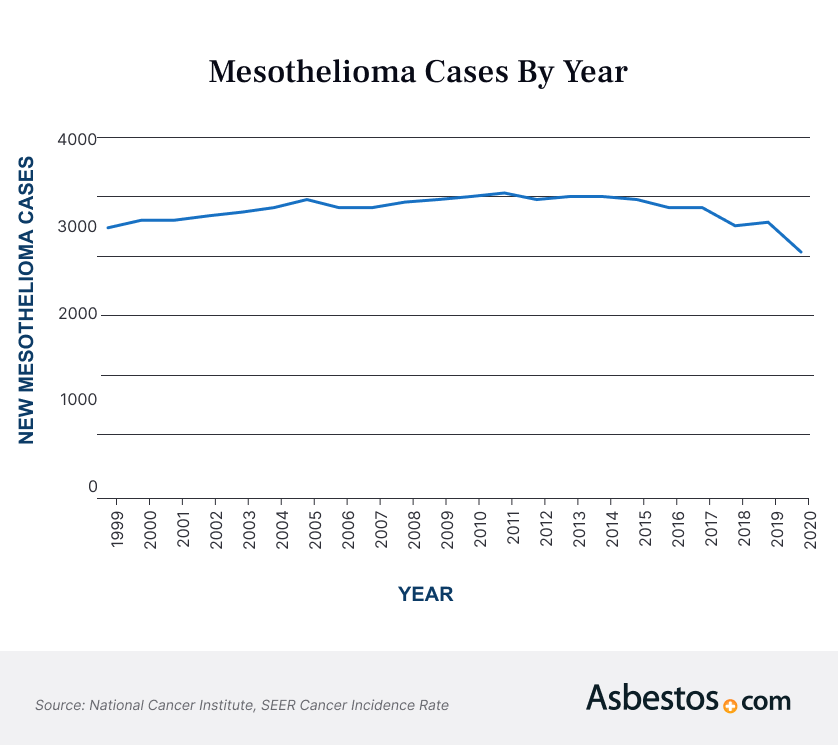
California reported 284 new cases, Florida reported 237, and Texas reported 206 in 2021. California, Pennsylvania, Texas, New York and Ohio had the highest mesothelioma-related mortalities between 2016 and 2021.
Areas with a strong history of industrial work and manufacturing have higher rates of asbestos-related diseases. States with naturally occurring asbestos deposits, like California and Montana, have high mesothelioma rates as well. CDC data from 2016-2021 shows the mesothelioma incidence rate in Montana is 1.2 per 100,000 people.
Highest Rates Per 100K People
Delaware’s mortality rate from 2018-2021 was 1 per 100,000 people. Maine’s was 1 per 100,000. Alaska’s was 1.2 per 100,000. Puerto Rico had a mortality rate of 0.1 per 100,000. Georgia had a mortality rate of 0.4 per 100,000.
In March 2024, the Biden-Harris administration finalized a ban on chrysotile asbestos in the United States. Regulations have restricted its use since the 1970s. As a result, experts believe incidence will decline in the future. However, mesothelioma’s long latency period means those exposed decades ago will continue to develop this cancer. People are also still exposed to legacy asbestos in older buildings and products today.
Get Your Free Mesothelioma Guide

Find a Top Mesothelioma Doctor

Access Help Paying for Treatment

Statistics vary depending on the location where mesothelioma tumors first develop. The incidence rate of pleural mesothelioma is significantly higher than for any other type. About 80% of cases occur in the pleura, the smooth tissue surrounding the lungs.
About 20% of cases are peritoneal mesothelioma. This occurs when tumors appear in the peritoneum, the lining of the abdomen. About 1% are pericardial cases. This mesothelioma type forms in the heart’s lining, the pericardium. Fewer than 1% of mesothelioma cases are testicular. Tumors in this type occur in the tunica vaginalis, the covering of the testes.
Tumor location also affects survival rates. About 73% of patients with pleural mesothelioma survive 1 year. The 5-year survival rate is 12%. For peritoneal mesothelioma, 92% survive 1 year. The 5-year survival rate is 65%. For pericardial mesothelioma, 26% survive 1 year. The 5-year survival rate is 9%.
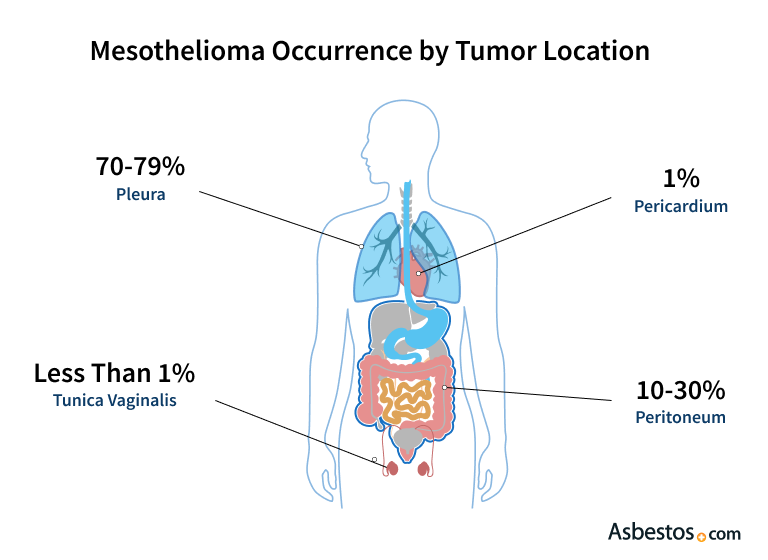
Treatment has a significant impact on life expectancy for patients. Mesothelioma treatment may involve surgery, chemotherapy and radiation therapy. While this cancer is difficult to treat, there have been important advances in mesothelioma treatment that are improving survival for patients.
A recent study presented at the European Lung Cancer Congress looked at the multimodal approach. This method combines two or more mesothelioma treatment options. It showed a combination of surgery, chemotherapy and radiation produced a 1-year survival rate of 79.6% for pleural mesothelioma patients.
Treatment’s Effect on Mesothelioma Survival
An International Journal of Hyperthermia study showed that the median disease-free survival was almost 5 years for peritoneal patients receiving HIPEC surgery. The median overall survival was more than 8 years.
A key to successful outcomes is beginning treatment as early as possible. Many mesothelioma symptoms are similar to other more common illnesses. They also often don’t appear until people are already in later stages. Regular screenings for those with asbestos exposure can help catch the disease early.

Gain access to top mesothelioma doctors and get help scheduling appointments.
Connect NowClinical trials give patients access to the latest breakthroughs in treatment. Researchers are testing new drug regimens for those who don’t qualify for surgery. These trials often include drugs already used in lung cancer treatment.
Director of the New York Mesothelioma Program at Mount Sinai Dr. Andrea Wolf says clinical trials have led to important advances in care. She explains, “The future of treatment for cancer, including mesothelioma, is now targeted therapy and immunotherapy.”
“The FDA has a number of new therapies approved,” Dr. Wolf adds. “We’re finding many of these are effective for mesothelioma patients who historically were difficult to treat with chemotherapy.”
Researchers have conducted more than 300 clinical trials worldwide for mesothelioma. The U.S. has conducted the largest number of mesothelioma clinical trials.
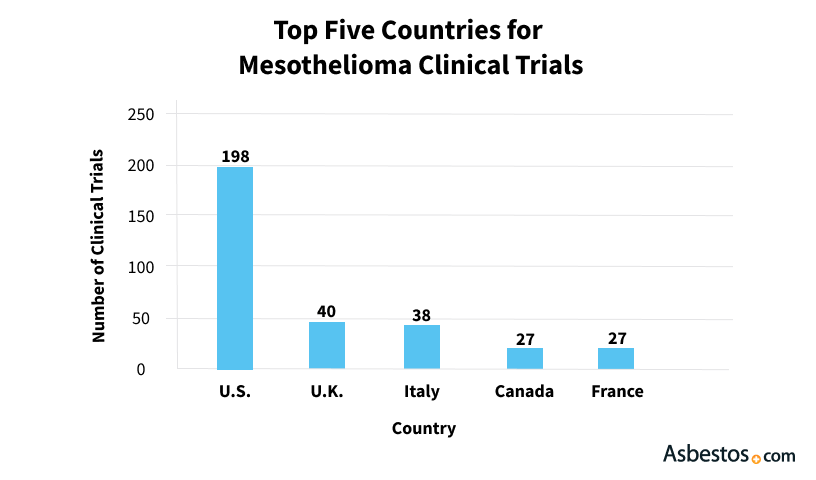
Government agencies break down and study mesothelioma statistics among different demographics to help understand risk and prognosis. Different age, gender and race or ethnicity have different incident rates.
This information also helps agencies identify and address disparities in access to screenings, diagnosis and treatment. As the Utah Department of Health and Human Services explains, “Analysis of public health data by demographic characteristics is essential to the reduction and elimination of health disparities.
CDC data from 2021 shows 32% of people are diagnosed with mesothelioma after age 80. Only 19% of people develop the disease between the ages of 75-79. About 4% of cases are among people between the ages of 35-49.
The latency period is generally shorter for peritoneal mesothelioma than for pleural mesothelioma. Most people diagnosed with peritoneal and pleural mesothelioma are about 51 and 67 years old, respectively.
Mesothelioma survivor Tamron tells us she wasn’t in the usual age demographic when diagnosed. She shares, “I was just 21 years old. My case was as rare as you can get.”
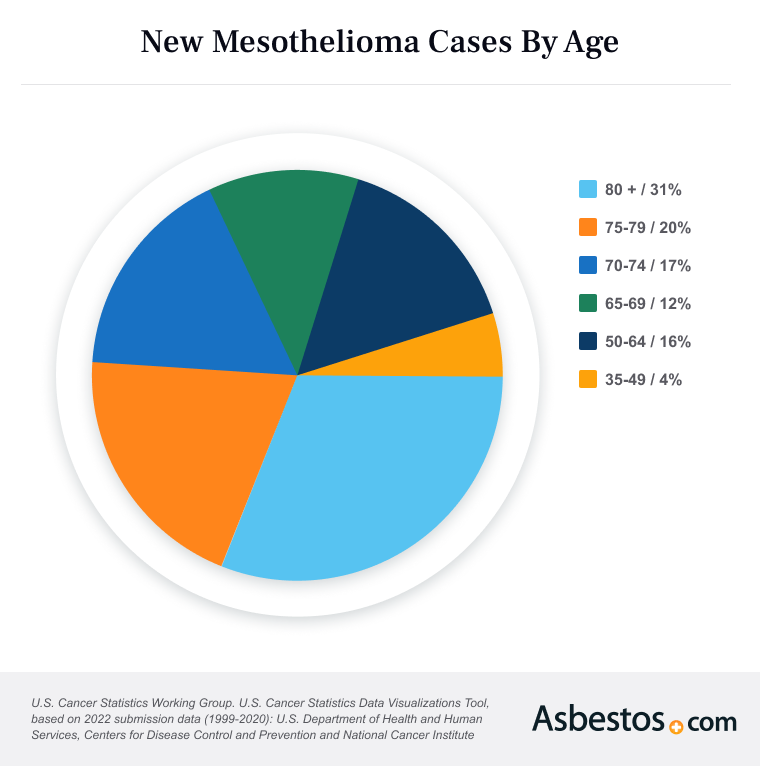
Younger patients have significantly higher mesothelioma survival rates than older patients. More than 50% of patients diagnosed before the age of 50 survive 1 year, while fewer than 33% of those 75 or older survive the same length of time.
There were 502 mesothelioma deaths among patients ages 85 and older in 2022, the latest year for which mortality by age is available.. That same year, 21 people between the ages of 45 and 49 died of mesothelioma.
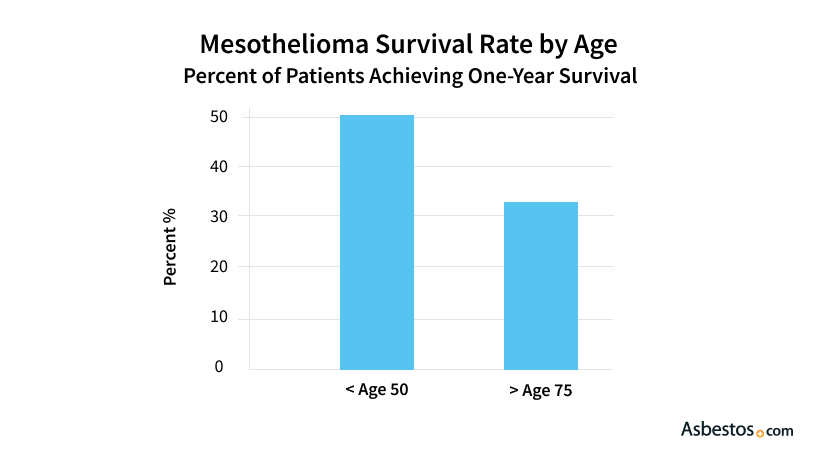
Historically, mesothelioma has been primarily diagnosed in men. According to the latest SEER data, in 2020, men made up nearly 71% of all cases, and women accounted for 29%. In 2021 CDC data, out of 2,803 diagnosed cases of mesothelioma, 1,973 were men, and 830 were women.
Women at the highest risk of developing mesothelioma from asbestos exposure are registered nurses, homemakers and teachers in elementary and middle school. A recent study found among people older than 44 years, mesothelioma incidence rates were higher among men. Among those younger than 45 years, women had higher incidence rates.
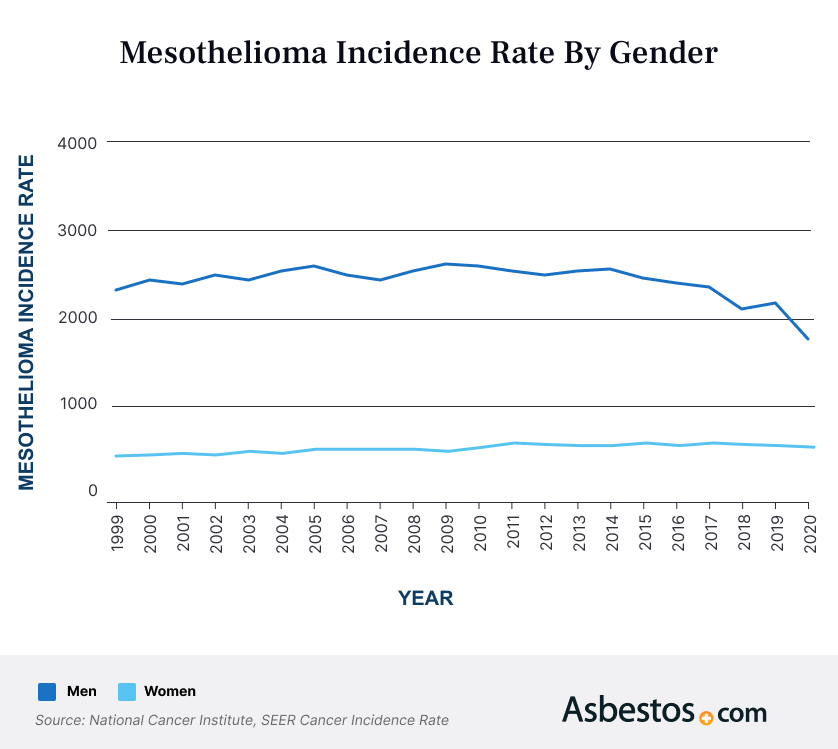
Women tend to have longer latency periods than men. It’s believed this is because they’re often exposed to lower levels of asbestos through secondhand exposure over time.
Men’s higher levels of occupational asbestos exposure likely result in a shorter latency period. The latency period for men is about 48 years. The latency period for women is about 53 years.
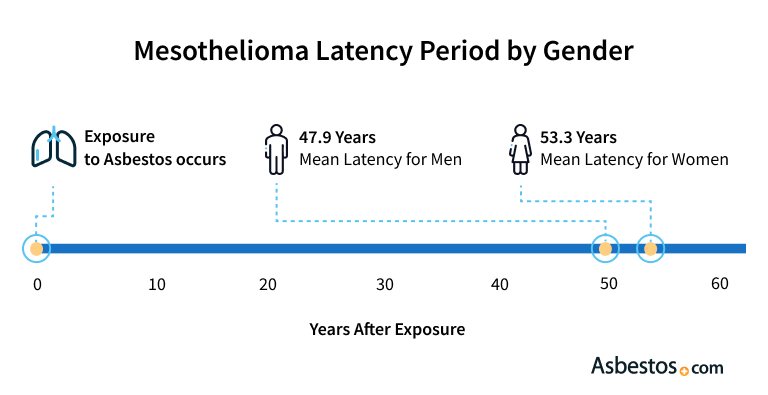
Women tend to have better survival rates than men. For example, the 5-year survival rate for women with pleural mesothelioma is about 16%. For men, it’s around 7%.
However, according to the CDC, mesothelioma deaths among women increased significantly. Mesothelioma cancer deaths for women increased 25% from 1999 to 2020. Combining statistics for both men and women, there were 2,376 mesothelioma deaths in 2020.
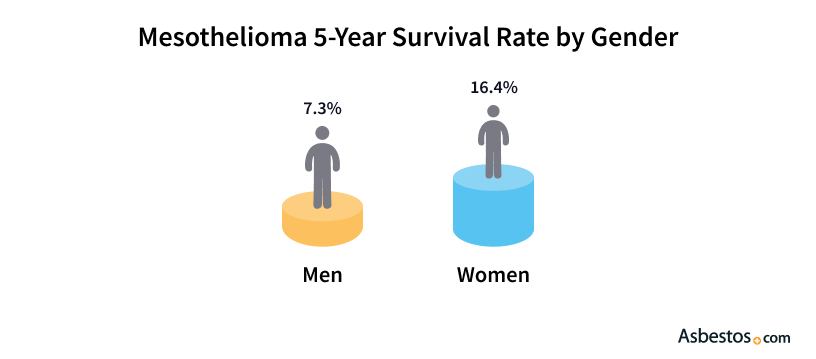
Most mesothelioma patients are non-Hispanic white, with 81% of cases in 2021. According to CDC data from 2017 to 2021, a total of 12,174 new mesothelioma cases were diagnosed in white individuals. This is in stark contrast to only 1,275 cases in Hispanic individuals and 741 new cases in non-Hispanic Black individuals.
SEER data shows a decline in mesothelioma incidence rates for non-Hispanic white individuals, from 1.3 to 0.8 cases per 100,000 people from 2000 to 2021. Incidence rates have remained fairly steady for Hispanic, non-Hispanic Black and non-Hispanic Asian/Pacific Islander populations.
The 5-year survival rate also appears to vary between races. The most recent year for compiled data by race is 2015 when the reported 5-year survival rate was about 19% for Black people and 9% for those who were white.
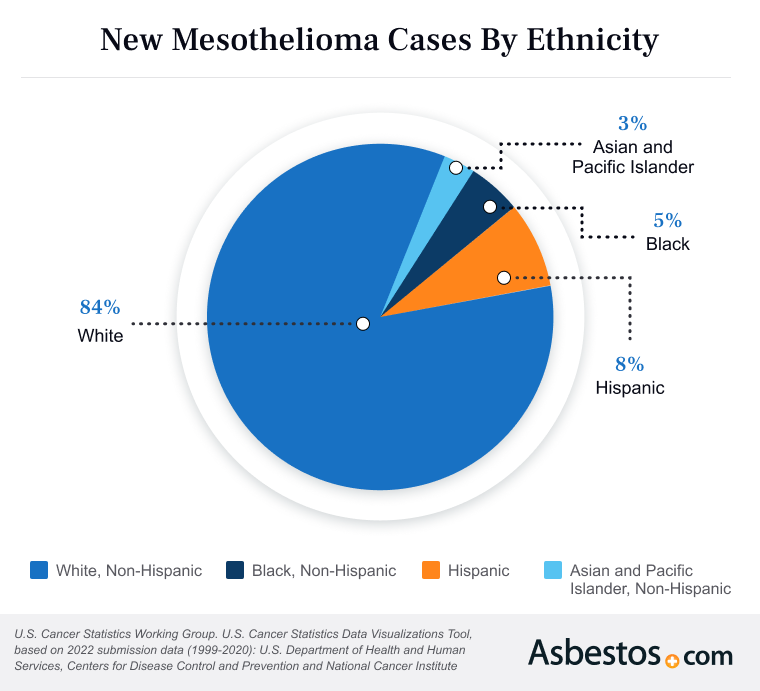
National Cancer Institute statistics estimate the cost of lung cancer treatment to be more than $60,000 for the first year. Mesothelioma treatment costs are comparable. Expenses can include medical bills, lost wages and travel costs.
Some people qualify for financial aid, such as VA benefits and Social Security Disability Insurance. Patients can also file legal claims to help cover costs. These include asbestos trust fund claims and mesothelioma lawsuits.
Mesothelioma Claims and Financial Compensation
As Patient Advocate and VA-accredited claims agent Danielle DiPietro notes, “It’s important for patients and families to seek out financial assistance. You really can’t expect what a diagnosis is going to cost for treatment or at-home care, or what your family’s needs are. So, it’s always important to plan for the future.”
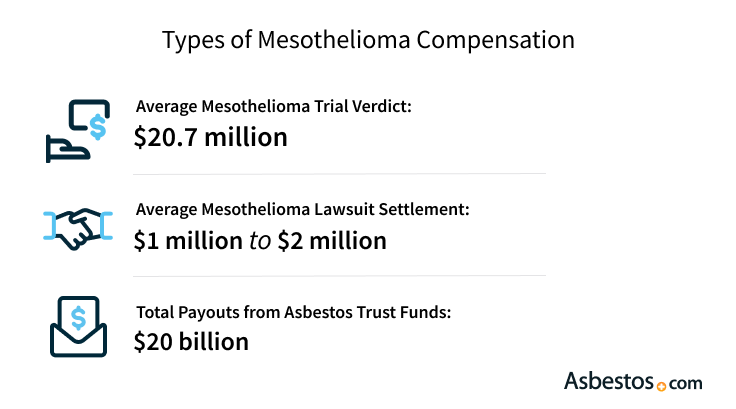
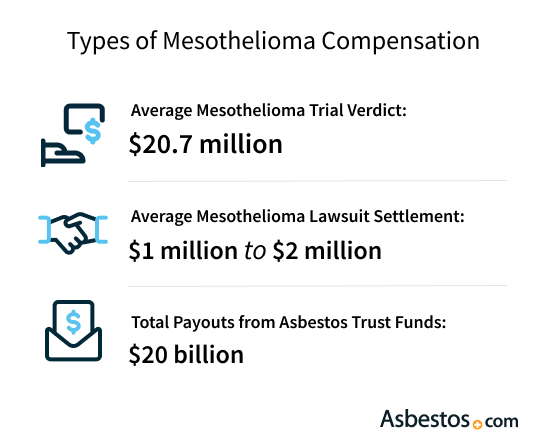
Additional cancer resources can provide more data and statistics. Local hospitals, cancer centers and nonprofit cancer organizations can also be helpful sources of statistical data.
Mesothelioma Information Resources
The Patient Advocates at The Mesothelioma Center can also provide you with key resources and information about mesothelioma. Their experience working with mesothelioma survivors and their families, top mesothelioma specialists and cancer treatment centers around the country have provided them with a unique point of view, making the team a valuable resource for the mesothelioma community as well.
Recommended ReadingYour web browser is no longer supported by Microsoft. Update your browser for more security, speed and compatibility.
If you are looking for mesothelioma support, please contact our Patient Advocates at (855) 404-4592
The Mesothelioma Center at Asbestos.com has provided patients and their loved ones the most updated and reliable information on mesothelioma and asbestos exposure since 2006.
Our team of Patient Advocates includes a medical doctor, a registered nurse, health services administrators, veterans, VA-accredited Claims Agents, an oncology patient navigator and hospice care expert. Their combined expertise means we help any mesothelioma patient or loved one through every step of their cancer journey.
More than 30 contributors, including mesothelioma doctors, survivors, health care professionals and other experts, have peer-reviewed our website and written unique research-driven articles to ensure you get the highest-quality medical and health information.
My family has only the highest compliment for the assistance and support that we received from The Mesothelioma Center. This is a staff of compassionate and knowledgeable individuals who respect what your family is experiencing and who go the extra mile to make an unfortunate diagnosis less stressful. Information and assistance were provided by The Mesothelioma Center at no cost to our family.LashawnMesothelioma patient’s daughter


Asbestos.com. (2025, April 8). Mesothelioma Statistics. Retrieved April 14, 2025, from https://www.asbestos.com/mesothelioma/statistics/
"Mesothelioma Statistics." Asbestos.com, 8 Apr 2025, https://www.asbestos.com/mesothelioma/statistics/.
Asbestos.com. "Mesothelioma Statistics." Last modified April 8, 2025. https://www.asbestos.com/mesothelioma/statistics/.
Dr. Jacques Fontaine is a thoracic surgeon at Moffitt Cancer Center in Tampa, Florida, where he heads up the Mesothelioma Research and Treatment Center. He specializes in minimally invasive robotic surgery and aggressive surgeries for mesothelioma.
Our fact-checking process begins with a thorough review of all sources to ensure they are high quality. Then we cross-check the facts with original medical or scientific reports published by those sources, or we validate the facts with reputable news organizations, medical and scientific experts and other health experts. Each page includes all sources for full transparency.
Please read our editorial guidelines to learn more about our content creation and review process.
